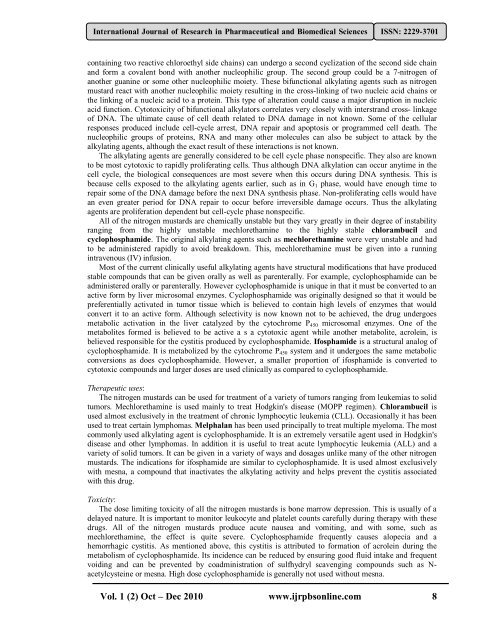Monitoring of Suspected Adverse Drug Reactions in Oncology Unit ...
Monitoring of Suspected Adverse Drug Reactions in Oncology Unit ...
Monitoring of Suspected Adverse Drug Reactions in Oncology Unit ...
Create successful ePaper yourself
Turn your PDF publications into a flip-book with our unique Google optimized e-Paper software.
International Journal <strong>of</strong> Research <strong>in</strong> Pharmaceutical and Biomedical Sciences ISSN: 2229-3701<br />
conta<strong>in</strong><strong>in</strong>g two reactive chloroethyl side cha<strong>in</strong>s) can undergo a second cyclization <strong>of</strong> the second side cha<strong>in</strong><br />
and form a covalent bond with another nucleophilic group. The second group could be a 7-nitrogen <strong>of</strong><br />
another guan<strong>in</strong>e or some other nucleophilic moiety. These bifunctional alkylat<strong>in</strong>g agents such as nitrogen<br />
mustard react with another nucleophilic moiety result<strong>in</strong>g <strong>in</strong> the cross-l<strong>in</strong>k<strong>in</strong>g <strong>of</strong> two nucleic acid cha<strong>in</strong>s or<br />
the l<strong>in</strong>k<strong>in</strong>g <strong>of</strong> a nucleic acid to a prote<strong>in</strong>. This type <strong>of</strong> alteration could cause a major disruption <strong>in</strong> nucleic<br />
acid function. Cytotoxicity <strong>of</strong> bifunctional alkylators correlates very closely with <strong>in</strong>terstrand cross- l<strong>in</strong>kage<br />
<strong>of</strong> DNA. The ultimate cause <strong>of</strong> cell death related to DNA damage <strong>in</strong> not known. Some <strong>of</strong> the cellular<br />
responses produced <strong>in</strong>clude cell-cycle arrest, DNA repair and apoptosis or programmed cell death. The<br />
nucleophilic groups <strong>of</strong> prote<strong>in</strong>s, RNA and many other molecules can also be subject to attack by the<br />
alkylat<strong>in</strong>g agents, although the exact result <strong>of</strong> these <strong>in</strong>teractions is not known.<br />
The alkylat<strong>in</strong>g agents are generally considered to be cell cycle phase nonspecific. They also are known<br />
to be most cytotoxic to rapidly proliferat<strong>in</strong>g cells. Thus although DNA alkylation can occur anytime <strong>in</strong> the<br />
cell cycle, the biological consequences are most severe when this occurs dur<strong>in</strong>g DNA synthesis. This is<br />
because cells exposed to the alkylat<strong>in</strong>g agents earlier, such as <strong>in</strong> G 1 phase, would have enough time to<br />
repair some <strong>of</strong> the DNA damage before the next DNA synthesis phase. Non-proliferat<strong>in</strong>g cells would have<br />
an even greater period for DNA repair to occur before irreversible damage occurs. Thus the alkylat<strong>in</strong>g<br />
agents are proliferation dependent but cell-cycle phase nonspecific.<br />
All <strong>of</strong> the nitrogen mustards are chemically unstable but they vary greatly <strong>in</strong> their degree <strong>of</strong> <strong>in</strong>stability<br />
rang<strong>in</strong>g from the highly unstable mechloretham<strong>in</strong>e to the highly stable chlorambucil and<br />
cyclophosphamide. The orig<strong>in</strong>al alkylat<strong>in</strong>g agents such as mechloretham<strong>in</strong>e were very unstable and had<br />
to be adm<strong>in</strong>istered rapidly to avoid breakdown. This, mechloretham<strong>in</strong>e must be given <strong>in</strong>to a runn<strong>in</strong>g<br />
<strong>in</strong>travenous (IV) <strong>in</strong>fusion.<br />
Most <strong>of</strong> the current cl<strong>in</strong>ically useful alkylat<strong>in</strong>g agents have structural modifications that have produced<br />
stable compounds that can be given orally as well as parenterally. For example, cyclophosphamide can be<br />
adm<strong>in</strong>istered orally or parenterally. However cyclophosphamide is unique <strong>in</strong> that it must be converted to an<br />
active form by liver microsomal enzymes. Cyclophosphamide was orig<strong>in</strong>ally designed so that it would be<br />
preferentially activated <strong>in</strong> tumor tissue which is believed to conta<strong>in</strong> high levels <strong>of</strong> enzymes that would<br />
convert it to an active form. Although selectivity is now known not to be achieved, the drug undergoes<br />
metabolic activation <strong>in</strong> the liver catalyzed by the cytochrome P 450 microsomal enzymes. One <strong>of</strong> the<br />
metabolites formed is believed to be active a s a cytotoxic agent while another metabolite, acrole<strong>in</strong>, is<br />
believed responsible for the cystitis produced by cyclophosphamide. Ifosphamide is a structural analog <strong>of</strong><br />
cyclophosphamide. It is metabolized by the cytochrome P 450 system and it undergoes the same metabolic<br />
conversions as does cyclophosphamide. However, a smaller proportion <strong>of</strong> ifosphamide is converted to<br />
cytotoxic compounds and larger doses are used cl<strong>in</strong>ically as compared to cyclophosphamide.<br />
Therapeutic uses:<br />
The nitrogen mustards can be used for treatment <strong>of</strong> a variety <strong>of</strong> tumors rang<strong>in</strong>g from leukemias to solid<br />
tumors. Mechloretham<strong>in</strong>e is used ma<strong>in</strong>ly to treat Hodgk<strong>in</strong>'s disease (MOPP regimen). Chlorambucil is<br />
used almost exclusively <strong>in</strong> the treatment <strong>of</strong> chronic lymphocytic leukemia (CLL). Occasionally it has been<br />
used to treat certa<strong>in</strong> lymphomas. Melphalan has been used pr<strong>in</strong>cipally to treat multiple myeloma. The most<br />
commonly used alkylat<strong>in</strong>g agent is cyclophosphamide. It is an extremely versatile agent used <strong>in</strong> Hodgk<strong>in</strong>'s<br />
disease and other lymphomas. In addition it is useful to treat acute lymphocytic leukemia (ALL) and a<br />
variety <strong>of</strong> solid tumors. It can be given <strong>in</strong> a variety <strong>of</strong> ways and dosages unlike many <strong>of</strong> the other nitrogen<br />
mustards. The <strong>in</strong>dications for ifosphamide are similar to cyclophosphamide. It is used almost exclusively<br />
with mesna, a compound that <strong>in</strong>activates the alkylat<strong>in</strong>g activity and helps prevent the cystitis associated<br />
with this drug.<br />
Toxicity:<br />
The dose limit<strong>in</strong>g toxicity <strong>of</strong> all the nitrogen mustards is bone marrow depression. This is usually <strong>of</strong> a<br />
delayed nature. It is important to monitor leukocyte and platelet counts carefully dur<strong>in</strong>g therapy with these<br />
drugs. All <strong>of</strong> the nitrogen mustards produce acute nausea and vomit<strong>in</strong>g, and with some, such as<br />
mechloretham<strong>in</strong>e, the effect is quite severe. Cyclophosphamide frequently causes alopecia and a<br />
hemorrhagic cystitis. As mentioned above, this cystitis is attributed to formation <strong>of</strong> acrole<strong>in</strong> dur<strong>in</strong>g the<br />
metabolism <strong>of</strong> cyclophosphamide. Its <strong>in</strong>cidence can be reduced by ensur<strong>in</strong>g good fluid <strong>in</strong>take and frequent<br />
void<strong>in</strong>g and can be prevented by coadm<strong>in</strong>istration <strong>of</strong> sulfhydryl scaveng<strong>in</strong>g compounds such as N-<br />
acetylcyste<strong>in</strong>e or mesna. High dose cyclophosphamide is generally not used without mesna.<br />
Vol. 1 (2) Oct – Dec 2010 www.ijrpbsonl<strong>in</strong>e.com 8

















